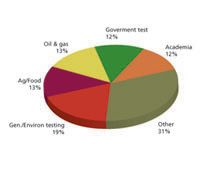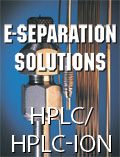GC–MS
Gas chromatography-mass spectrometry (GC-MS) is the most widespread tandem technique in the analytical instrumentation industry. In fact, these systems account for the largest installed base of mass spectrometry instruments.
Gas chromatography–mass spectrometry (GC–MS) is the most widespread tandem technique in the analytical instrumentation industry. In fact, these systems account for the largest installed base of mass spectrometry instruments. GC–MS systems are extremely versatile and are employed across many different industries, particularly for environmental, chemical and toxicological applications. But it is also a mature market, based predominantly on replacement system sales and aftermarket revenue. In addition, growth of GC-MS systems comes in part at the expense of GC as many labs replace their GCs with GC-MS systems.

Demand by Industry
There are several types of mass analyzers used in GC–MS, which include quadrupole, ion trap, magnetic sector, and time-of-flight. Quadrupole analyzers are by far the most popular variety of mass analyzers because they provide a reliable, cost-effective, and robust solution to most applications. However, the demand for other classes of mass analyzers are fueling growth in the GC–MS market as a result of a growing trend of applications requiring lower detection limits and better resolution.
Magnetic sector mass spectrometers are the oldest mass spectrometry technology and provide highly reproducible results combined with high resolution and sensitivity. Ion trap systems are gaining wider acceptance in the marketplace as they offer high sensitivity and simple maintenance. Ion Trap GC–MS offers tandem MS, which improves selectivity in the analysis of mixtures, lowers detection limits, and provides structural information, which is very applicable to forensic and life science applications, particularly drug discovery, synthesis, and metabolism.
Time-of-flight analyzers provide the quickest analysis and have the highest practical mass range of all analyzers. GC-TOF systems are relatively expensive, costing upwards of $150,000. However, most advocates of the technology agree that the systems are definitely worth the investment.
The top five industries, which include general/environmental testing, agriculture and food, oil and gas, government testing, and academia account for more than two thirds of the worldwide GC–MS market demand. Other industries with lesser presence include chemicals, pharmaceuticals, government research, and contract research organizations, among others.
The foregoing data was extracted and adapted from SDi's Global Assessment Report, Edition 10.5. For more information, contact Glenn Cudiamat, VP of Research Services, Strategic Directions International, Inc., 6242 Westchester Parkway, Suite 100, Los Angeles, CA 90045, tel. (310) 641-4982, fax (310) 641-8851, e-mail:cudiamat@strategic-directions.com
Regulatory Deadlines and Supply Chain Challenges Take Center Stage in Nitrosamine Discussion
April 10th 2025During an LCGC International peer exchange, Aloka Srinivasan, Mayank Bhanti, and Amber Burch discussed the regulatory deadlines and supply chain challenges that come with nitrosamine analysis.
Top Execs from Agilent, Waters, and Bruker Take the Stage at J.P. Morgan Healthcare Conference
January 16th 2025The 43rd Annual Healthcare J.P. Morgan Healthcare Conference kicked off in San Francisco earlier this week. Here’s what top executives from Agilent, Bruker, and Waters, discussed during the event.

.png&w=3840&q=75)

.png&w=3840&q=75)



.png&w=3840&q=75)



.png&w=3840&q=75)


